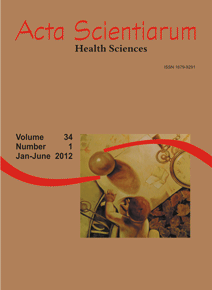<b>Prevalência de infecções hospitalares em um hospital geral de alta complexidade no município de Ponta Grossa</b> - doi: 10.4025/actascihealthsci.v34i1.8943
Resumo
Pacientes internados em instituições de saúde estão expostos a uma variedade de micro-organismos patogênicos. Fatores como tempo de permanência, ventilação mecânica e procedimentos invasivos contribuem para o desenvolvimento de infecções hospitalares, necessitando de vigilância permanente por parte das Comissões de Controle de Infecção Hospitalar (CCIH). O objetivo foi traçar perfil das infecções de um hospital de alta complexidade do município de Ponta Grossa, Estado do Paraná, determinando a prevalência de infecção hospitalar nas Unidades de Internação, UTI Adulto e UTI Neonatal; o perfil de sensibilidade aos antimicrobianos. Estudo descritivo, retrospectivo, quantitativo, com 768 infecções tratadas em 2007; 36,8% de origem comunitária; 63,2% hospitalares - 16,3% da UTI Neonatal, 27,8% da UTI Adulto e 55,9% das Unidades. As bactérias mais prevalentes nas unidades são: Escherichia coli; Staphylococcus aureus; Pseudomonas aeruginosa. UTI Adulto: Acinetobacter baumannii; Staphylococcus aureus; Escherichia coli. UTI Neonatal: SNPC; Staphylococcus aureus; Klebsiella pneumoniae. Destacamos alta sensibilidade das Acinetobacter baumannii à Ampicilina/Subactam e Tobramicina; eficácia do Meropenem, Ciprofloxaxina e Vancomicina; baixa prevalência de Staphylococcus aureus resistente à Meticilina/MRSA. Estes indicadores apresentaram valores significativos de prevalência e sensibilidade antimicrobiana, resultado dos critérios utilizados pela CCIH da instituição pesquisada - realização de vigilância epidemiológica; Antibiograma Escalonado; monitoramento das prescrições de antimicrobianos; e treinamento dos funcionários.
Downloads
DECLARAÇÃO DE ORIGINALIDADE E DIREITOS AUTORAIS
Declaro que o presente artigo é original, não tendo sido submetido à publicação em qualquer outro periódico nacional ou internacional, quer seja em parte ou em sua totalidade.
Os direitos autorais pertencem exclusivamente aos autores. Os direitos de licenciamento utilizados pelo periódico é a licença Creative Commons Attribution 4.0 (CC BY 4.0): são permitidos o acompartilhamento (cópia e distribuição do material em qualqer meio ou formato) e adaptação (remix, transformação e criação de material a partir do conteúdo assim licenciado para quaisquer fins, inclusive comerciais.
Recomenda-se a leitura desse link para maiores informações sobre o tema: fornecimento de créditos e referências de forma correta, entre outros detalhes cruciais para uso adequado do material licenciado.























5.png)







